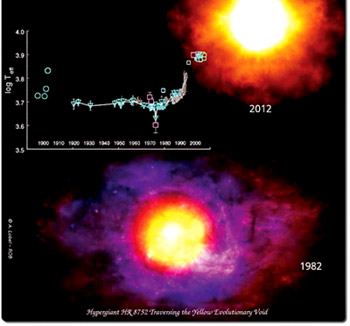Hyper-giant star probed for 30 years
A European research team has published the results of a 30-year study
of an extraordinary hypergiant star. They have found that the surface
temperature of the super-luminous star HR 8752 increased by about 3000
degrees in less than three decades, while it went through an extremely
rare stage called the 'Yellow Evolutionary Void'. The discovery marks an
important step closer to unravelling the evolution of the most massive
stars.
 A team of astronomers from six European countries, including the
Royal Observatory of Belgium (ROB), has investigated the hypergiant star
HR 8752 for 30 years while it traversed the 'Yellow Evolutionary Void'.
The 'Void' is a short stage in the lives of the most massive stars when
they become very unstable. The team finds that the surface temperature
of HR 8752 rose surprisingly fast from 5000 to 8000 degrees in less than
30 years. A team of astronomers from six European countries, including the
Royal Observatory of Belgium (ROB), has investigated the hypergiant star
HR 8752 for 30 years while it traversed the 'Yellow Evolutionary Void'.
The 'Void' is a short stage in the lives of the most massive stars when
they become very unstable. The team finds that the surface temperature
of HR 8752 rose surprisingly fast from 5000 to 8000 degrees in less than
30 years.
The research results were very recently published in the journal
Astronomy and Astrophysics. The discovery is an important step forward
to resolve the enigma of the hypergiants, the most luminous and massive
stars of the Galaxy.
Hypergiants can shine millions of times brighter than the Sun, and
they often have a diameter several hundred times greater. HR 8752 is a
quarter million times more luminous than the Sun.
The powerhouse is, therefore, visible with normal binoculars at large
distance from Earth in the Northern constellation of Cassiopeia. There
are currently only 12 hypergiants known in our Galaxy.
The 'Yellow Evolutionary Void' is a unique stage in the short life of
a hypergiant when its temperature and luminosity can quickly change. The
team has discovered that the atmospheres are very unstable inside the
Void because outwardly directed forces act equal or sometimes even
stronger than the force of gravity.
Due to the unstable atmosphere, hypergiants lose tremendous weight in
this 'forbidden zone', which can sometimes amount to the mass of the Sun
in a year.
When a hypergiant enters the 'Evolutionary Void' the star tries to it
leave as quickly as possible. That is why almost all hypergiants are
found outside the Void.
The team finds that HR 8752 is a very rare hypergiant which has
partly traversed the Void. The changes of its atmosphere were closely
monitored with regular observations over 30 years.
Alex Lobel, co-author of the study and ROB scientist explains that
"HR 8752 was around 1980 identical to the eruptive hypergiant Rho Cas of
spectral type F, but then the temperature of HR 8752's atmosphere
rapidly increased by 3000 degrees and now shows the spectral properties
of a hotter A-type star. We are baffled about the tremendous changes of
HR 8752 in that period of time."
Between 1900 and 1980 the atmospheric temperature of HR 8752 stayed
almost constant around 5000 degrees, but it rose very rapidly to 8000
degrees between 1985 and 2005. The team calculates that the stellar
radius decreased from 750 to 400 times that of the Sun. In 1985 the team
embarked on a long-term spectroscopic observing program when it found
that the remarkable hypergiant was exactly at the border of the 'Yellow
Void' and started to cross over. "HR 8752 had to struggle through the
Void which has changed the physical properties of its atmosphere," Lobel
adds.
The team further demonstrates that the Void actually consists of two
parts in which the atmosphere of the hypergiant is unstable. They result
from ionization of large amounts of hydrogen and helium gas in the
atmosphere, divided by a small zone around 8000 degrees where it becomes
more stable.
The fate of HR 8752 is currently unclear but there are strong hints
that these massive hypergiants may perish in a powerful supernova
explosion. Or they quickly traverse the Void and transform into a hotter
type of erratic stars known as the "Luminous Blue Variables."
In either case that will not pass unnoticed according to Kees de
Jager and Hans Nieuwenhuijzen, the astronomers of the Netherlands
Institute for Space Research in Utrecht who directed the research of HR
8752 over the past three decades.
The discovery is an important new step for explaining the existence
of these extreme stars. A number of other hypergiants with similar
spectacular properties is expected to exist in the Milky Way.
The search for these remarkable stars with dramatic changes over
human timescales has just begun, but has been forever put on track.
- ScienceDaily
|



